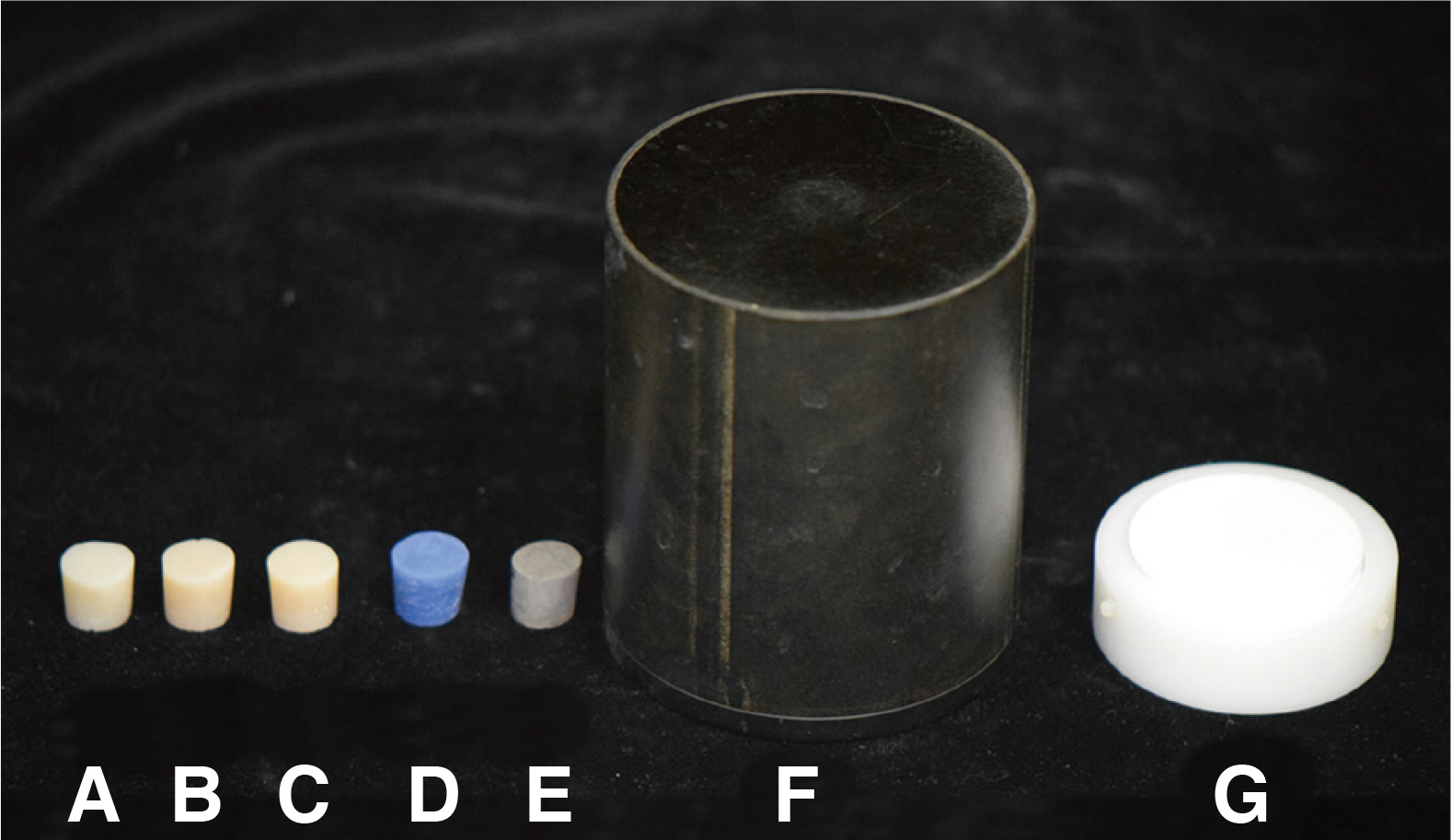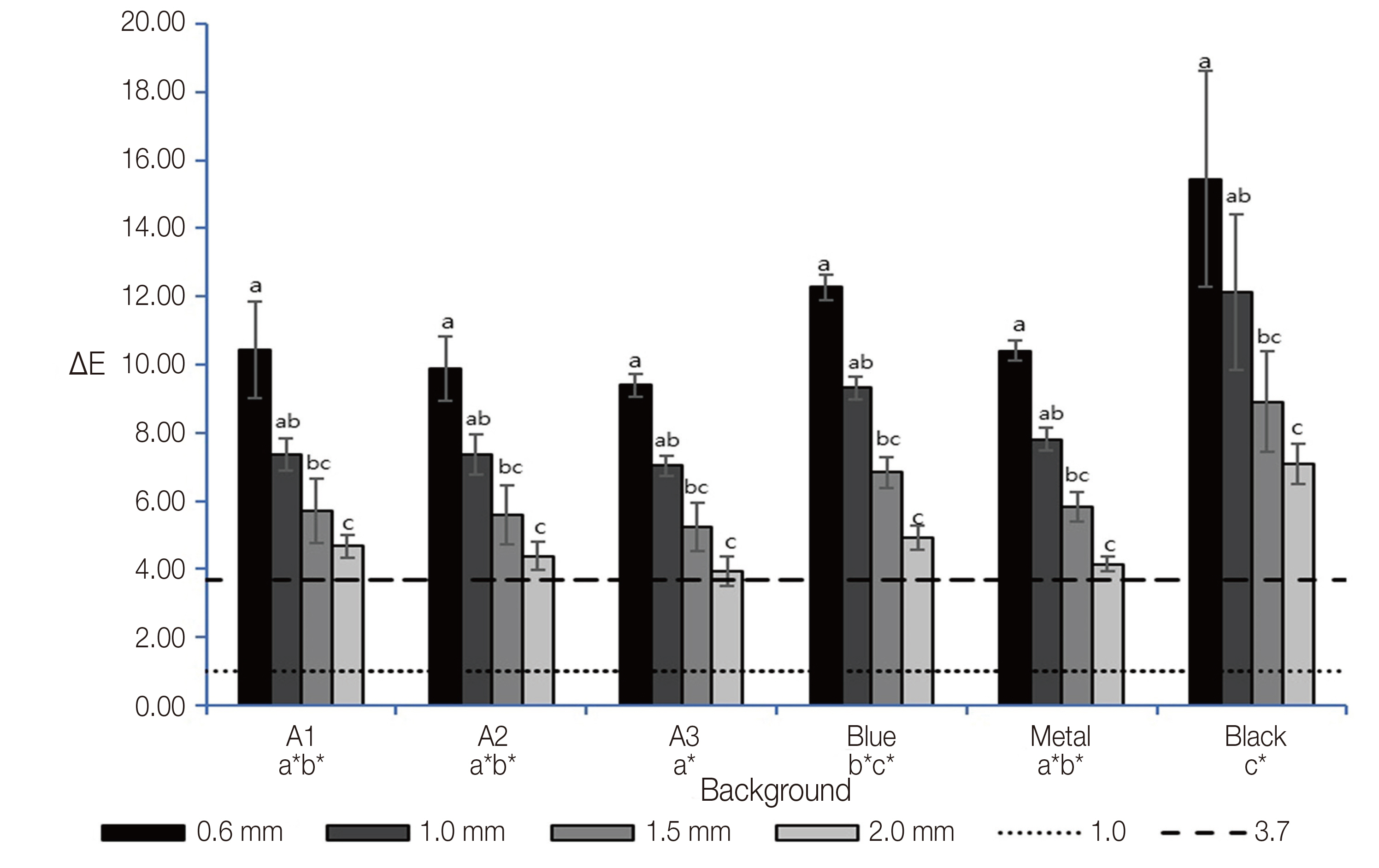J Dent Rehabil Appl Sci.
2021 Dec;37(4):199-208. 10.14368/jdras.2021.37.4.199.
Effects of thickness and background on the masking ability of high -trasnlucent zirconias
- Affiliations
-
- 1Department of Prosthodontics, College of Dentistry, Wonkwang University, Iksan, Republic of Korea
- KMID: 2525994
- DOI: http://doi.org/10.14368/jdras.2021.37.4.199
Abstract
- Purpose
The purpose of this study was to compare and evaluate the masking ability of three types of high translucent zirconia according to the various thicknesses and backgrounds.
Materials and Methods
Using three types of high-translucency zirconia (Ceramill zolid fx white, Ceramill zolid ht+ white, Ceramill zolid ht+ preshade A2), 10 cylindrical specimens were fabricated in 10mm diameter and each with four thicknesses (0.6 mm, 1.0 mm, 1.5 mm, 2.0 mm), respectively by CAD/CAM method. The background was 10 mm in diameter and 10 mm in thickness. A1, A2, A3 flowable resin backgrounds, blue-colored core resin background, and Ni-Cr alloy background were prepared, and black, white backgrounds provided by the spectrophotometer manufacturer (x-rite, Koblach, Austria) were used. zirconia specimens and the background specimen were stacked to measure L, a*, b* with Spectrophotometer (Color i5, x-rite, Koblach, Austria) and the ∆E value with the other background is calculated. The Calculated mean ∆E values were compared based on perceptibility threshold 1.0 and acceptability threshold 3.7. Nonparametric tests such as Kruskal-Wallis test were performed to verify statistical significance (α = 0.05).
Results
There was a significant difference in the mean ∆E value according to the zirconia type, background and thickness change (P = 0.000).
Conclusion
According to the results of this study, the pre-colored high-translucent zirconia can obtain the desired zirconia shade when it is restored on teeth, composite resins, and abutments except for the blue resin core.
Keyword
Figure
Reference
-
References
1. Raptis NV, Michalakis KX, Hirayama H. 2006; Optical behavior of current ceramic systems. Int J Periodontics Restorative Dent. 26:31–41. PMID: 16515094.2. Zarone F, Russo S, Sorrentino R. 2011; From porcelainfused-to-metal to zirconia: clinical and experimental considerations. Dent Mater. 27:83–96. DOI: 10.1016/j.dental.2010.10.024. PMID: 21094996.3. Jeong ID, Bae SY, Kim DY, Kim JH, Kim WC. 2016; Translucency of zirconia-based pressable ceramics with different core and veneer thicknesses. J Prosthet Dent. 115:768–72. DOI: 10.1016/j.prosdent.2015.11.003. PMID: 26794702.4. Vichi A, Louca C, Corciolani G, Ferrari M. 2011; Color related to ceramic and zirconia restorations: A review. Dent Mater. 27:97–108. DOI: 10.1016/j.dental.2010.10.018. PMID: 21122905.5. Heffernan MJ, Aquilino SA, Diaz-Arnold AM, Haselton DR, Stanford CM, Vargas MA. 2002; Relative translucency of six all-ceramic systems. Part I: core materials. J Prosthet Dent. 88:4–9. DOI: 10.1067/mpr.2002.126794. PMID: 12239472.6. Al Ben Ali A, Kang K, Finkelman MD, Zandparsa R, Hirayama H. 2014; The effect of variations in translucency and background on color differences in CAD/CAM lithium disilicate glass ceramics. J Prosthodont. 23:213–20. DOI: 10.1111/jopr.12080. PMID: 23889762.7. Tabatabaian F, Taghizade F, Namdari M. 2018; Effect of coping thickness and background type on the masking ability of a zirconia ceramic. J Prosthet Dent. 119:159–65. DOI: 10.1016/j.prosdent.2017.03.009. PMID: 28478989.8. Brodbelt RH, O'Brien WJ, Fan PL. 1980; Translucency of Dental Porcelains. J Dent Res. 59:70–5. DOI: 10.1177/00220345800590011101. PMID: 6927988.9. Wang F, Takahashi H, Iwasaki N. 2013; Translucency of dental ceramics with different thicknesses. J Prosthet Dent. 110:14–20. DOI: 10.1016/S0022-3913(13)60333-9. PMID: 23849609.10. Kanchanavasita W, Triwatana P, Suputtamongkol K, Thanapitak A, Chatchaiganan M. 2014; Contrast Ratio of Six Zirconia-Based Dental Ceramics. J Prosthodont. 23:456–61. DOI: 10.1111/jopr.12143. PMID: 24750270.11. Sulaiman TA, Abdulmajeed AA, Donovan TE, Ritter AV, Vallittu PK, Närhi TO, Lassila LV. 2015; Optical properties and light irradiance of monolithic zirconia at variable thicknesses. Dent Mater. 31:1180–7. DOI: 10.1016/j.dental.2015.06.016. PMID: 26198027.12. Baldissara P, Llukacej A, Ciocca L, Valandro FL, Scotti R. 2010; Translucency of zirconia copings made with different CAD/CAM systems. J Prosthet Dent. 104:6–12. DOI: 10.1016/S0022-3913(10)60086-8. PMID: 20620365.13. Matsuzaki F, Sekine H, Honma S, Takanashi T, Furuya K, Yajima Y, Yoshinari M. 2015; Translucency and flexural strength of monolithic translucent zirconia and porcelain-layered zirconia. Dental Mater. 34:910–7. DOI: 10.4012/dmj.2015-107. PMID: 26632242.14. Passos L, Linke B, Street A, Torrealba Y. 2019; Effect of thickness, translucency, and firing protocol on the masking ability of a CADCAM zirconia-reinforced lithium silicate for different backgrounds. Int J Comput Dent. 22:29–38. PMID: 30848252.15. Spyropoulou PE, Giroux EC, Razzoog ME, Duff RE. 2011; Translucency of shaded zirconia core material. J Prosthet Dent. 105:304–7. DOI: 10.1016/S0022-3913(11)60056-5. PMID: 21530755.16. Lim HN, Yu B, Lee YK. 2010; Spectroradiometric and spectrophotometric translucency of ceramic materials. J Prosthet Dent. 104:239–46. DOI: 10.1016/S0022-3913(10)60131-X. PMID: 20875528.17. Lindsey DT, Wee AG. 2007; Perceptibility and acceptability of CIELAB color differences in computer‑simulated teeth. J Dent. 35:593–9. DOI: 10.1016/j.jdent.2007.03.006. PMID: 17517460. PMCID: PMC2041906.18. Ishikawa-Nagai S, Yoshida A, Sakai M, Kristiansen J, Da Silva JD. 2009; Clinical evaluation of perceptibility of color differences between natural teeth and allceramic crowns. J Dent. 37 Suppl 1:e57–63. DOI: 10.1016/j.jdent.2009.04.004. PMID: 19423209.19. Douglas RD, Steinhauer TJ, Wee AG. 2007; Intraoral determination of the tolerance of dentists for perceptibility and acceptability of shade mismatch. J Prosthet Dent. 97:200–8. DOI: 10.1016/j.prosdent.2007.02.012. PMID: 17499089.20. Khashayar G, Bain PA, Salari S, Dozic A, Kleverlaan CJ, Feilzer AJ. 2014; Perceptibility and acceptability thresholds for colour differences in dentistry. J Dent. 42:637–44. DOI: 10.1016/j.jdent.2013.11.017. PMID: 24334221.21. Tabatabaian F, Shabani S, Namdari M, Sadeghpour K. 2017; Masking ability of a zirconia ceramic on composite resin substrate shades. Dent Res J (Isfahan). 14:389–94. DOI: 10.4103/1735-3327.218562. PMID: 29238377.22. Powers JM, Dennison JB, Lepeak PJ. 1978; Parameters that affect the color of direct restorative resins. J Dent Res. 57:876–80. DOI: 10.1177/00220345780570090701. PMID: 281361.23. Johnston WM, Ma T, Kienle BH. 1995; Translucency parameter of colorants for maxillofacial prostheses. Int J Prosthodont. 8:79–86. PMID: 7710631.24. Nassary Zadeh P, Lümkemann N, Sener B, Eichberger M, Stawarczyk B. 2018; Flexural strength, fracture toughness, and translucency of cubic/tetragonal zirconia materials. J Prosthet Dent. 120:948–54. DOI: 10.1016/j.prosdent.2017.12.021. PMID: 29807742.25. Oh SH, Kim SG. 2015; Effect of abutment shade, ceramic thickness, and coping type on the final shade of zirconia all-ceramic restorations: in vitro study of color masking ability. J Adv Prosthodont. 7:368–74. DOI: 10.4047/jap.2015.7.5.368. PMID: 26576252. PMCID: PMC4644777.26. Shimada K, Nakazawa M, Kakehashi Y, Matsumura H. 2006; Influence of abutment materials on the resultant color of heat-pressed lithium disilicate ceramics. Dent Mater J. 25:20–5. DOI: 10.4012/dmj.25.20. PMID: 16706292.27. Sen N, Sermet IB, Cinar S. 2018; Effect of coloring and sintering on the translucency and biaxial strength of monolithic zirconia. J Prosthet Dent. 119:308. e1-7. DOI: 10.1016/j.prosdent.2017.08.013. PMID: 29150133.28. Spyropoulou PE, Giroux EC, Razzoog ME, Duff RE. 2011; Translucency of shaded zirconia core material. J Prosthet Dent. 105:304–7. DOI: 10.1016/S0022-3913(11)60056-5. PMID: 21530755.29. Tabatabaian F, Dalirani S, Namdari M. 2019; Effect of Thickness of Zirconia Ceramic on Its Masking Ability: An In Vitro Study. J Prosthodont. 28:666–71. DOI: 10.1111/jopr.12625. PMID: 28452411.30. Kim HK, Kim SH, Lee JB, Han JS, Yeo IS, Ha SR. 2016; Effect of the amount of thickness reduction on color and translucency of dental monolithic zirconia ceramics. J Adv Prosthodont. 8:37–42. DOI: 10.4047/jap.2016.8.1.37. PMID: 26949486. PMCID: PMC4769888.31. Malkondu O, Tinastepe N, Kazazoglu E. 2016; Influence of type of cement on the color and translucency of monolithic zirconia. J Prosthet Dent. 116:902–8. DOI: 10.1016/j.prosdent.2016.05.001. PMID: 27422235.32. Kürklü D, Azer SS, Yilmaz B, Johnston WM. 2013; Porcelain thickness and cement shade effects on the colour and translucency of porcelain veneering materials. J Dent. 41:1043–50. DOI: 10.1016/j.jdent.2013.08.017. PMID: 24004966.33. Tabatabaian F, Habib Khodaei M, Namdari M, Mahshid M. 2016; Effect of cement type on the color attributes of a zirconia ceramic. J Adv Prosthodont. 8:449–56. DOI: 10.4047/jap.2016.8.6.449. PMID: 28018562. PMCID: PMC5179483.
- Full Text Links
- Actions
-
Cited
- CITED
-
- Close
- Share
- Similar articles
-
- Translucency and masking ability of translucent zirconia; comparison with conventional zirconia and lithium disilicate
- The effect of thickness of the provisional crown and fixed partial denture materials on the translucency and masking effect
- Choice of resin cement shades for a high-translucency zirconia product to mask dark, discolored or metal substrates
- Opacity and masking effect of the opaque shade composite resins
- Effect of coloring treatment of translucent zirconia on the masking ability of metal abutment







